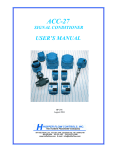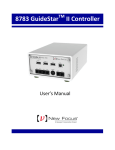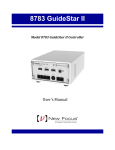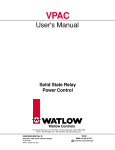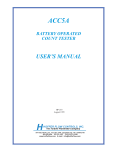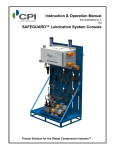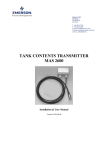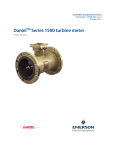Download Model ACC34AC Signal Conditioner/Converter (AC)
Transcript
ACC-34 (AC Powered Version) MAG COIL FLOW RATE CONDITIONER FREQUENCY TO ANALOG VOLTAGE HP-245-AC October 2006 107 Kitty Hawk Lane, P.O. Box 2145, Elizabeth City, NC 27906-2145 800-628-4584 252-331-1997 FAX 252-331-2886 www.hofferflow.com E-mail: [email protected] Notice HOFFER FLOW CONTROLS, INC. MAKES NO WARRANTY OF ANY KIND WITH REGARD TO THIS MATERIAL, INCLUDING, BUT NOT LIMITED TO, THE IMPLIED WARRANTIES OF MERCHANTABILITY AND FITNESS FOR A PARTICULAR PURPOSE. This manual has been provided as an aid in installing, connecting, calibrating, operating, and servicing this unit. Every precaution for accuracy has been taken in the preparation of this manual; however, HOFFER FLOW CONTROLS, INC. neither assumes responsibility for any omissions or errors that may appear nor assumes liability for any damages that may result from the use of products in accordance with information contained in the manual. HOFFER FLOW CONTROLS’ policy is to provide a user manual for each item supplied. Therefore, all applicable user manuals should be examined before attempting to install or otherwise connect a number of related subsystems. During installation, care must be taken to select the correct interconnecting wiring drawing. The choice of an incorrect connection drawing may result in damage to the system and/or one of the components. Please review the complete model of each item to be connected and locate the appropriate manual(s) and/or drawing(s). Identify all model numbers exactly before making any connections. A number of options and accessories may be added to the main instrument, which are not shown on the basic user wiring. Consult the appropriate option or accessory user manual before connecting it to the system. In many cases, a system wiring drawing is available and may be requested from HOFFER FLOW CONTROLS. This document contains proprietary information, which is protected by copyright. All rights are reserved. No part of this document may be photocopied, reproduced, or translated to another language without the prior consent of HOFFER FLOW CONTROLS, INC. HOFFER FLOW CONTROLS’ policy is to make running changes, not model changes, whenever an improvement is possible. This affords our customers the latest in technology and engineering. The information contained in this document is subject to change without notice. RETURN REQUESTS/INQUIRIES Direct all warranty and repair requests/inquiries to the Hoffer Flow Controls Customer Service Department, telephone number (252) 331-1997 or 1-800-628-4584. BEFORE RETURNING ANY PRODUCT(S) TO HOFFER FLOW CONTROLS, PURCHASER MUST OBTAIN A RETURNED MATERIAL AUTHORIZATION (RMS) NUMBER FROM HOFFER FLOW CONTROLS’ CUSTOMER SERVICE DEPARTMENT (IN ORDER TO AVOID PROCESSING DELAYS). The assigned RMA number should then be marked on the outside of the return package and on any correspondence. FOR WARRANTY RETURNS, please have the following information available BEFORE contacting HOFFER FLOW CONTROLS: 1. P.O. number under which the product was PURCHASED, 2. Model and serial number of the product under warranty, and 3. Repair instructions and/or specific problems relative to the product. HFC 9708 FOR NON-WARRANTY REP A I RS OR CALIBRATIONS, consult HOFFER FLOW CONTROLS for current repair/calibration charges. Have the following information available BEFORE contacting HOFFER FLOW CONTROLS: 1. P.O. number to cover the COST of the repair/calibration, 2. Model and serial number of the product, and 3. Repair instructions and/or specific problems relative to the product. LIMITED WARRANTY HOFFER FLOW CONTROLS, INC. (“HFC”) warrants HFC’s products (“goods”) described in the specifications incorporated in this manual to be free from defects in material and workmanship under normal use and service, but only if such goods have been properly selected for the service intended, properly installed and properly operated and maintained. This warranty shall extend for a period of (1) year from the date of delivery to the original purchaser (or eighteen (18) months if the delivery to the original purchaser occurred outside the continental United States). This warranty is extended only to the original purchaser (“Purchaser”). Purchaser’s sole and exclusive remedy is the repair and/or replacement of nonconforming goods as provided in the following paragraphs. In the event Purchaser believes the goods are defective, the goods must be returned to HFC, transportation prepaid by Purchaser, within twelve (12) months after delivery of goods (or eighteen (18) months for goods delivered outside the continental United States) for inspection by HFC. If HFC’s inspection determines that the workmanship or materials are defective, the goods will be either repaired or replaced, at HFC’s sole determination, free of additional charge, and the goods will be returned, transportation paid by HFC, using the lowest cost transportation available. Prior to returning the goods to HFC, Purchaser must obtain a Returned Material Authorization (RMA) Number from HFC’s Customer Service Department within 30 days after discovery of a purported breach of warranty, but no later than the warranty period; otherwise, such claims shall be deemed waived. See the Return Requests/Inquiries Section of this manual. If HFC’s inspection reveals the goods are free of defects in material and workmanship or such inspection reveals the goods were improperly used, improperly installed, and/or improperly selected for service intended, HFC will notify the purchaser in writing and will deliver the goods back to purchaser upon (i) receipt of Purchaser’s written instructions and (ii) the cost of transportation. If Purchaser does not respond within 30 days after notice from HFC, the goods will be disposed of in HFC’s discretion. HFC does not warrant these goods to meet the requirements of any safety code of any state, municipality, or any other jurisdiction, and purchaser assumes all risk and liability whatsoever resulting from the use thereof, whether used singly or in combination with other machines or apparatus. This warranty shall not apply to any HFC goods or parts thereof, which have bee repaired outside HFC’s factory or altered in any way, or have been subject to misuse, negligence, or accident, or have not been operated in accordance with HFC’s printed instructions or have been operated under conditions more severe than, or otherwise exceeding, those set forth in the specifications for such goods. THIS WARRANTY IS EXPRESSLY IN LIEU OF ALL OTHER WARRANTIES, EXPRESSED OR IMPLIED, INCLUDING ANY IMPLIED WARRANTLY OF MERCHANTABILITY OR FITNESS FOR A PARTICULAR PURPOSE. HFC SHALL NOT BE LIABLE FOR ANY LOSS OR DAMAGE RESULTING, DIRECTLY OR INDIRECTLY, FROM THE USE OF LOSS OF USE OF THE GOODS. WITHOUT LIMITING THE GENERALITY OF THE FOREGOING, THIS EXCLUSION FROM LIABILITY EMBRACES THE PURCHASER’S EXPENSES FOR DOWNTIME, DAMAGES FOR WHICH THE PURCHASER MAY BE LIABLE TO OTHER PERSONS, DAMAGES TO PROPERTY, AND INJURY TO OR DEATH OF ANY PERSON. HFC NEITHER ASSUMES NOR AUTHORIZES ANY PERSON TO ASSUME FOR IT ANY OTHER LIABILITY IN CONNECTION WITH THE SALE OR USE OF HFC’S GOODS, AND THERE ARE NO AGREEMENTS OR WARRANTIES COLLATERAL TO OR AFFECTING THE AGREEMENT. PURCHASER’S SOLE AND EXCLUSIVE REMEDY IS THE REPAIR AND/OR REPLACEMENT OF NONCONFORMING GOODS AS PROVIDED IN THE PRECEDING PARAGRAPHS. HFC SHALL NOT BE LIABLE FOR ANY OTHER DAMAGES WHATSOEVER INCLUDING INDIRECT, INCIDENTAL, OR CONSEQUENTIAL DAMAGES. Disclaimer: Specifications are subject to change without notice. Some pages are left intentionally blank. HFC 9708 TALE OF CONTENTS SECTION I INTRODUCTION AND SPECIFICATIONS ACC-34 PAGE 1.1 SECTION II INSTALLATION 2.1 SECTION III CALIBRATION 3.1 SECTION IV OPERATION 4.1 SECTION V MAINTENANCE AND MAIN SCHEMATIC 5.1 HP-245-AC THIS PAGE INTENTIONALLY LEFT BLANK. ACC-34 HP-245-AC SECTION I ACC-34 MAGNETIC PICKOFF CONDITIONER/CURRENT CONVERTER The Model ACC-34 is a signal converter subsystem that provides an analog current output signal that is directly proportional to flow rate. Several options are available to suit user requirements. An auxiliary pulse output is also provided. These features combine to form an interface between a flow transducer and a host system. The input signal conditioning circuitry is designed to accept the low level flowmeter signal while providing rejection of unwanted noise and spurious signal. A signal threshold control is provided which allows the user to set the input sensitivity above the ambient noise level, thereby eliminating any false signal on the output. Several output pulse configurations are provided which offer flexibility in the interface required by the host system. The output is available in the form of CMOS/TTL compatible pulse or in the form of an open collector. SPECIFICATIONS INPUT Input protected, RF and band pass filtered, adjustable trigger level. Input Impedance - 40 Kilo ohm (nominal). Trigger Sensitivity - 10 millivolt RMS (minimum) 10 Hz to 1000 Hz. Over Voltage - 120 volts RMS absolute (maximum). Compatible with magnetic pickoffs. ANALOG OUTPUT Range 4 to 20 mA. Controls - Non-interacting zero and span adjustments. Accuracy ±0.1% F. S. 200 ppm/EC. Maximum Impedance - 325 ohms. F. S. Frequency Range 75 Hz to 2500 Hz (DIP SWITCH SELECTABLE). PULSE SCALING CAPABILITY (OPTIONAL) ÷2, ÷4, ÷8, ÷16, ÷32, ÷64, ÷128.and ÷256 ACC-34 1.1 HP-245-AC PULSE OUTPUT TTL/CMOS COMPATIBLE OPTION LOGIC 1 2.4V at -.800mA. LOGIC 0 0.4V maximum at 100mA. OPEN COLLECTOR OPTION TYPE VMOS 2N6660 V Max. (Abs.) 60 VDC. I Max. (Abs.) 100 mA. AC OPTION 5Vp p Square Wave. POWER REQUIREMENTS (OPTIONAL) 115 VAC 50/60 Hz. 15-35 VDC. TEMPERATURE 0E to 70EC Standard. ENCLOSURE OPTIONS Standard enclosure Style-2 Case (See outline drawing). Explosion-Proof Enclosure. Explosion-Proof Enclosure with 'O' ring seal. NEMA-4 Enclosure. CONTROLS AND ADJUSTMENTS FUSE A circuit protection device located inside of case. SENSITIVITY A multiple turn control used to set the threshold sensitivity level above the ambient noise pickup. RANGE A dual in-line (DIP) switch located on the PCA-61 board, which is used to program the module to accept an input frequency range. SPAN A multiple turn adjustment which is used to set the voltage output signal to the desired span corresponding to the equivalent flow range (i.e., 4 to 20mA corresponding to 0-100 GPM). ZERO A multiple turn adjustment which is used to set output signal with no flow to the desired 'zero' value (i.e., 4mA). SCALING FACTOR A dual in-line (DIP) switch located on the PCA-60 board which is used to set the pulse scaling device factor to ÷2, ÷4, ÷8, ÷16, ÷32, ÷64, ÷128 and 256. ACC-34 1.2 HP-245-AC ORDERING INFORMATION MODEL ACC34-( A )-( B )-( C )-( D )-( E ) PULSE OUTPUT ANALOG OUTPUT INPUT POWER OPTIONAL FEATURE ENCLOSURE STYLE PULSE OUTPUT MODEL ACC34-( A )-( )-( )-( )-( ) OPTION ( A ) (1) OPEN COLLECTOR (2) TTL/CMOS (3) AC SQUARE WAVE (5) 0-10 V SQUARE WAVE ANALOG OUTPUT MODEL ACC34-( )-( B )-( )-( )-( ) OPTION ( B ) (X) NONE (C) 4-20 MA (C1) 4-20 MA (ISOLATED) INPUT POWER MODEL ACC34-( )-( )-( C )-( )-( OPTION ( C ) (A) 115 VAC 50/60 HZ (B) 220 VAC 50/60 HZ (D) 15-35 VDC ) OPTIONAL FEATURE MODEL ACC34-( )-( )-( )-( D )-( ) OPTION ( D ) (PS) DIP SWITCH SELECTABLE DIVIDE BY 2,4,8,16,32,64,128 ENCLOSURE STYLE MODEL ACC34-( )-( )-( )-( )-( E ) OPTION ( E ) (2) STYLE 2 CASE, GENERAL PURPOSE (4/O) STYLE 4 CASE, EXPLOSION-PROOF WITH WATER TIGHT ‘O’ RING MEETS CLASS I, GROUP C, D (ADALET CASE, XJS WITH FLAT COVER) STOCK #200-0698 CLASS II, GROUPS E, F & G CLASS III NOTE: ACC-34 INSERT (X) IN MODEL NUMBER FOR EVERY OPTION NOT SPECIFIED. 1.3 HP-245-AC THIS PAGE INTENTIONALLY LEFT BLANK. ACC-34 1.4 HP-245-AC SECTION II FLOWMETER INSTALLATION GENERAL Proper application of the turbine flowmeter requires a suitable piping installation in order to achieve accurate and reliable operation. The piping configuration immediately preceding and following the flowmeter is termed the meter run. Refer to the manufacturer's outline and installation instructions when installing the flowmeter and meter run. RELATIVE: The performance of the turbine flowmeter is affected by the fluid swirl and nonuniform velocity profiles. The following recommendation will reduce such flow irregularities: It is advisable not to locate the meter run immediately downstream of pumps, partially opened valves, bends or other similar piping configurations. In addition, the area surrounding the flowmeter should be free of sources of electrical noise such as motors, solenoids, transformers and power lines which may be coupled to the pickoff device. The metering section should not be subjected to excessive vibration or shock. Such a condition may result in a mechanically induced output signal from the pickoff device. METER RUN: In general, the meter run should be chosen to have the same inner diameter as the meter bore. A minimum of 10 pipe diameters of straight pipe upstream and 5 pipe diameters downstream are required. Where this optimum line configuration can not be implemented, it is advisable to install a flow straightener properly positioned upstream of the flowmeter. Orientation is not a critical factor, however, horizontal is preferred orientation. BYPASS RUN: A properly sized bypass run with suitable blocking valves may be equipped where an interruption in fluid flow for turbine meters servicing cannot be tolerated. STRAINER: A strainer, filter and/or air eliminator is recommended to reduce the potential of fouling or damage. See table for recommended mesh size. On initial startup of a line, it is advisable to install a spool piece purging the line to eliminate damaging the flowmeter, due to flux, tape, solder, welds or other contaminates carried along by the fluid stream. CAVITATION: Cavitation causes measurement inaccuracies in turbine flowmeters and should be avoided by suitable line and operating configurations. Whenever the pressure within a pipeline instantaneously falls below the equilibrium vapor pressure of the fluid, a portion of the fluid vaporizes and forms bubbles in the pipeline. This is termed cavitation. Cavitation is eliminated by maintaining adequate back pressure on the flowmeter. A downstream valve that provides the necessary back pressure is one means for preventing cavitation in the metering run. Control valves should be located downstream, if possible. Some installations may also make use of a vapor eliminator upstream of the flowmeter. The minimum required back pressure may be estimated using the following equation: Min. Back Pressure = 1.25 X Vapor Pressure + 2X Pressure Drop ACC-34 2.1 HP-245-AC INSTALLATION WIRING LAYOUT FOR INTERCONNECTIONS USING MCP PICKUP In considering the interconnections between the flowmeter and the flow measurement system some attention must be given to anticipated noise sources and to the coupling of these noise sources to the interconnecting wiring. Noise signals may be coupled inductively or capacitively into the wiring between the flowmeter and the electronic measuring systems. In general, utilizing a shielded, twisted pair for the interconnection greatly reduces this coupling. The shield should be grounded on one end of the cable only. In general, grounding only on the electronic measuring system is best. However, even with proper interconnecting cabling Crosstalk with other signal lines or power lines may still occur and should be avoided. Physical isolation in the manner in which the wiring is run reduces the chance of potential problems. It is common to transmit the low level output signal form the flowmeter several hundred feet through a shielded, twisted pair instrument cable. Where a noisy environment is suspect, it is recommended that a preamplifier be installed on or near the flowmeter to the electronic measuring system. Suitable accessory models are available from manufacturer. INSTALLATION ACC-34 (AC POWERED VERSION The Model ACC-34 should be placed in a convenient location, which maintains access to the unit should repairs or readjustment be required. Refer to outline and installation drawing for the appropriate case type to be installed. Drill appropriate mounting holes as required. Refer to wiring installation drawing for appropriate terminals for interconnections. Connections to the terminal block should be carefully dressed to avoid having bare wires extend pass the screw clamp on the terminal block. This is particularly important for units mounted within the explosionproof enclosure. Wires should be neatly dressed near the bottom of the enclosure to assure wiring will not become fouled when the cover is installed. Connect two conductor shielded cable from the flowmeter. Connect shield to ACC-34 only. Line power connection should be made through a circuit breaker so that power can be turned off while servicing accessory model. Power is 117V AC +/- 10%, an earth ground connection is also required. Connect pulse output if used, several output pulse waveforms are available factory equipped. Wire to appropriate terminal for waveform desired and specified. If the analog output has been equipped, connect wiring to appropriate terminals and load. A shielded, twisted pair wire is recommended. Ground shield on one end only. Use some precautions as described for flowmeter input signal. ACC-34 2.2 HP-245-AC THIS PAGE INTENTIONALLY LEFT BLANK. ACC-34 2.3 HP-245-AC SECTION III CALIBRATION OF ANALOG OUTPUT - GENERAL CONSIDERATIONS INTRODUCTION In general, all flow measurement systems by Hoffer Flow Controls have been factory calibrated as specified by the user, at the time of purchase, free of charge. All systems which underwent such a factory calibration have a calibration card attached prior to shipment. This card contains the details of analog outputs, as well as, other useful calibration data. Field calibration is only required when a change has occurred or is sought to the measuring system. Such a change may be due to repair, replacement or recalibration of the flowmeter, or perhaps a change in the analog output span. PROCEDURE Begin by determining the equivalent maximum volumetric flow rate in GPM, expected by the application, term this GPM(MAX). GPM(MAX) may be calculated based on the analog output scale requirements or may be the maximum flow rate listed on the flowmeter's calibration sheet. From the calibration constant (or K-Factor) listed on the data sheet for the flowmeter, obtain the frequency corresponding to GPM(MAX) using Equation-1 and designate this frequency F(MAX). Equation-1: F MAX = K AVG X GPM MAX 60 The analog output of the ACC-34 may be calibrated with the aid of an external oscillator used in conjunction with a frequency counter. The external oscillator is used to supply a test frequency. In this method, the external oscillator is connected to the signal input terminals as shown in Figure-1. The oscillator's output frequency is set to equal F(MAX) as indicated on the frequency counter. 1. The course range adjustment is accomplished by selecting a switch position on a DIP switch located on the PCA-61 printed circuit card. See Table A to determine required switch position and set into switch as shown on drawing ACC-34-403 for anticipated F(MAX). NOTE: Input power should be removed during this step. It is necessary to open the cover of the enclosure by removing two screws and lifting the cover. Two printed circuit cards are attached. The “RANGE” Dip Switch may be programmed with a pen. 2. 3. 4. 5. Connect a digital milliampmeter or equivalent, across the current output terminals. Adjust ZERO control for desired zero current (i.e. 4mA). Turn SPAN POT fully CCW until detent is felt or 25 turns. Inject the test frequency equal to FMAX while adjusting “SPAN” for current equal to 20mA ±20mA. See test setup shown in Figure-1. 6. Iterate steps 4 and 5 until no change is observed. ACC-34 3.1 HP-245-AC FOR PULSE SCALING OPTION 1. An optional DIP switch is located on the PCA-60 printed circuit card. See Table B to determine required switch position and set into switch, as shown in drawing ACC34-403, for required divided by N. 2. For a required divide by 64, 128 or 256, switch position 6 must be jumpered as shown on drawing ACC34-403. TABLE A F(MAX) RANGE SELECT SWITCH POSITION 75 to 150 1 150 to 300 2 300 to 600 3 600 to 1200 4 1200 to 2400 5 ÷N SWITCH POSITION 2 1 4 2 8 3 16 4 32 5 64* 128* 256* 6 TABLE B *NOTE: For divide by 64, 128 or 256, switch position 6 is jumpered to appropriate location of PCA-60 printed circuit board. ACC-34 3.2 HP-245-AC SECTION IV ACC34 FREQUENCY/CURRENT FLOW CONVERTER SUBSYSTEM INITIAL STARTUP Perform any purging of piping with spool piece in place. Once completed, install the flowmeter and connect cabling to pickup coil. If false counting action occurs turn sensitivity control clockwise. OPERATION The pulse output and analog output commence with flow through the flowmeter. For the analog output, the span is then established by either the factory calibration or field calibration. The range is 4-20mA DC into a maximum of 325 ohms of loop resistance. PRINCIPLE OF OPERATION A simplified block diagram of the ACC34 Frequency/Current Flow Converter Subsystem is given on drawing ACC34-601. Key functional blocks, as well as, information flow are designated. The basic operation of the system is as follows: The frequency signal from the flowmeter is connected to the ACC34 with a twisted pair shielded cable. The signal enters through the SENSITIVITY control which is used to reject unwanted noise by raising the trigger threshold above the background noise present. The low level flowmeter signal is then passed through a special conditioning chain where it is amplified and shaped into a train of digital pulses whose frequency is related to the volume flow rate. ANALOG OUTPUT The signal entering the frequency to analog converter is passed through a combination of divide by N and DIP switch MATRIX. The QN output is chosen, whose pulse rate is between 75 and 150 Hz at the maximum flow rate to be measured. This scaled pulse rate is fed into a precision monostable circuit. The output of the monostable is then filtered into an analog voltage that is proportional to volumetric flow rate. The output amplifier is a voltage to current amplifier. It offers zero and span available in a standard process range of 4-20mA. ACC-34 4.1 HP-245-AC THIS PAGE INTENTIONALLY LEFT BLANK. ACC-34 4.2 HP-245-AC SECTION V MAINTENANCE, GENERAL Hoffer Flow Controls Flow Measurement Systems are constructed to give a long service life in the targeted measuring field and service environment. However, problems do occur from time to time and the following points should be considered for preventive maintenance and repairs. The bearing type used in the flowmeter chosen to give compromise between long life, chemical resistance, ease of maintenance and performance. A preventive maintenance schedule should be established to determine the amount of wear which has occurred since last overhaul. See user's manual for flowmeter for further instructions. A spare parts list has been provided, which at the discretion of the user, may be user-stocked. Consult with the manufacturer is an abridged spare parts list is sought. The recommended spare parts list may be found following this section and in the user's manual for the flowmeter. In case the flow measurement system malfunctions or becomes inoperative, a troubleshooting procedure is enclosed. Factory consultation is available to assist in diagnosing problems. In addition, factory repair parts and service are available for individuals who wish to utilize this service. A complete set of schematic diagrams for all printed cards are available from Hoffer Flow Controls for users who wish their own personnel to service the measuring system. NOTE: - All printed circuit cards are warranted for one year after date of sale. - All printed circuit cards may be factory repaired at a nominal fee for parts and labor after warrantee period. TROUBLESHOOTING AND MAINTENANCE INTRODUCTION In case of an inoperable or malfunctioning system the following procedures can be used to isolate the faulty wiring, printed circuit boards and/or alternate causes. The majority of repairs can be made in the field thereby reducing the time a unit is out of service. A recommended spare parts list is given immediately following the troubleshooting portion of this manual. The necessary documentation is contained within this manuals with the exception of the calibration data sheet for the turbine flowmeter. This calibration is supplied separately. Factory consultation is available to assist in diagnosing problems. Note that in some cases factory repairs can be provided. Failure conditions are listed and the possible corrective actions given to eliminate the observed problem. ACC-34 5.1 HP-245-AC GENERAL INSPECTION TO DETERMINE IF UNIT IS OPERATING PROPERLY Proper operation of the ACC34 can be assumed when with power applied to the unit: 1. The pulse output produces a pulse train of the desired amplitude when flow through the flow transducer occurs. 2. The analog output produces a current output signal of 4-20mA with a span corresponding to that established by the calibration procedure. OBSERVED CONDITION CORRECTIVE ACTION A. NO PULSE OUTPUT 1. Inspect terminal strip wiring for conformity to the installation instructions and for acceptable workmanship. 2. Verify correct fuse is good with an ohm meter. See dwg. ACC34-403. 3. Determine if flowmeter rotor is fouled. 4. Defective pickup coil. Replace. 5. Defective cable. Replace. 6. Defective ACC34. Repair or replace. 7. Sensitivity potentiometer turned fully clockwise unit will not function properly. B. PULSING OUTPUT WITH NO FLOW 1. Defective pickup coil. Replace. 2. Defective cable. Replace. 3. Defective ACC34. Repair or replace. C. ANALOG OUTPUT MALFUNCTION NOTE: 1. Improper wiring terminations. Correct wiring. 2. ACC34 improperly calibrated. Recalibrate. 3. Defective circuitry within the ACC34. Factory repair ACC34. Refer to flowmeter user's manual for repair instructions for the turbine flowmeter. MODEL ACC34 FREQUENCY/CURRENT FLOW CONVERTER SUBSYSTEM TABLE 1 - RECOMMENDED SPARE PARTS LIST PART NUMBER DESCRIPTION QTY. 1/20 AMP FUSE, POWER SUPPLY 1 BOX ACC34-XX CONDITIONER/CONVERTER 1 PC-XX-XX COIL 1 NOTE: Additional spare parts may be recommended for the turbine flowmeter. See user's manual for turbine flowmeter for details. ACC-34 5.2 HP-245-AC





























